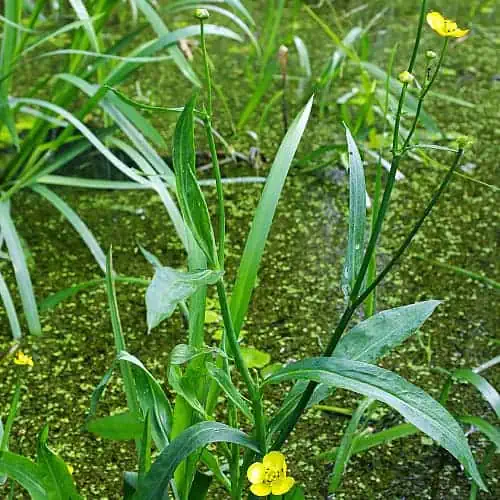
A semiaquatic flowering plant, Ranunculus lingua grandiflora is known by several common names, including water buttercup, great spearwort, and greater spearwort. This species is in the Ranunculaceae (buttercup) family, members of which can be found essentially worldwide. Water buttercup specifically is native to temperate regions of Europe and parts of Asia.
Water buttercup produces beautiful bright yellow flowers that closely resemble other buttercup varieties. However, unlike a “classic” buttercup, water buttercup tends to grow on the margins of water sources such as ponds, as it requires access to significant amounts of water. Lesser spearwort (Ranunculus flammula) is a very similar species, but its flowers are much smaller.
Water buttercup can be planted deeper than many other marginal plants (up to 60cm deep), making it a unique addition to ponds. This plant creates excellent shade and protective cover for fish and invertebrates living in the water below it. Water buttercup can also be a valuable host plant for butterfly larvae, and pollinators like various bees, butterflies, and moths are likely to pay the vibrant yellow flowers many visits throughout the flowering season.
Water Buttercup Growth, Hardiness & Climate

As suggested by its name, water buttercup grows best in thoroughly saturated soil. This plant can often be naturally found at the margins of ponds, streams, lakes, and wetlands as these areas allow it to get as much water as it needs. A robust plant, water buttercup does not typically need much care if grown in the right conditions. A water buttercup plant can grow to be around five feet tall. Even when not in bloom, this plant is an eye-catching addition to ponds and gardens because of its attractive, long blade-like leaves.
Water buttercup typically flowers during the summer, producing bright yellow blooms that make beautiful additions to ponds and water gardens. This plant does best in hardiness zones 4-9, and is winter-hardy in these areas, returning year after year.
How to Plant Water Buttercup In Ponds

Water buttercup tends to be an easy plant to care for, provided is has enough water and sunlight. Planting it in the shallows of your pond or in saturated soils along the edge of the water will help to ensure it can thrive in an ideal environment.
As water buttercup can spread through rhizomes, you can divide its roots as needed to control spreading. Be sure to properly dispose of whatever you are not replanting, and clean any trimmed or dropped foliage from your pond to encourage healthy water quality. Be careful when dividing water buttercup roots, as this plant will output skin-irritating toxins when it experiences damage. Wear gloves to be safe, and don’t touch your face after handling.
How to Care For Water Buttercup

Water buttercup will thrive best when grown in full sun to partial shade and very moist soil. Letting this species grow in the margins of your pond will give it a good chance to flourish. Once established, this plant needs little maintenance. Seedlings should be kept moist. If you need to control the growth of your water buttercup, you can divide the plant and either transplant or dispose of the remainder.
How to Winter Water Buttercup
Water buttercup is native to areas with cold winters and is able to survive winters as low as hardiness zone 4. There is no need for any special treatment to prepare this species for the winter in its native zones. Keep in mind that water buttercup is a perennial, so you should expect to see it in your pond for multiple years.
Is Water Buttercup Toxic, Poisonous or Invasive?
Water buttercup can be invasive, especially outside of its native ranges in Europe and Asia. As always, carefully consider whether you want to introduce any non-native plants to your garden – it is always best to utilize plants native to your region, as these won’t negatively impact surrounding ecosystems and the creatures that rely on them.
Like all species in the Ranunculus genus, water buttercup is toxic if eaten fresh. Buttercups can even irritate the skin when crushed or broken parts of the plant are handled, so take care if you decide to grow this species. The source of this skin irritation is a chemical reaction within the plant. Ranunculus species contain ranunculin, which breaks down into a toxin called protoanemonium when the plant is wounded. This toxin causes rashes on the skin, as well as nausea, vomiting, and other unpleasant side effects when consumed.
Is Water Buttercup Edible? Will Fish Eat it?
Water buttercup is not edible. In fact, buttercup species have been known to poison livestock when they consume large amounts of it in the absence of other options. The good news is that these plants have a very unpleasant taste, so most animals avoid them entirely. Water buttercup is a common pond plant and is not known to create any dangers for pond fish, and fish do not seem to show interest in eating it. To be on the safe side, you can plant water buttercup either in saturated soil without standing water or in very shallow water that your fish will be unable to access.
Where to Buy Water Buttercup & Seeds? (UK & US)
Water buttercup is easily obtained at plant nurseries throughout its native range. Elsewhere in the world, you will likely have to order it online if you are set on growing it in your own pond or garden. As always, please take care when selecting plants that are not native to your area.

